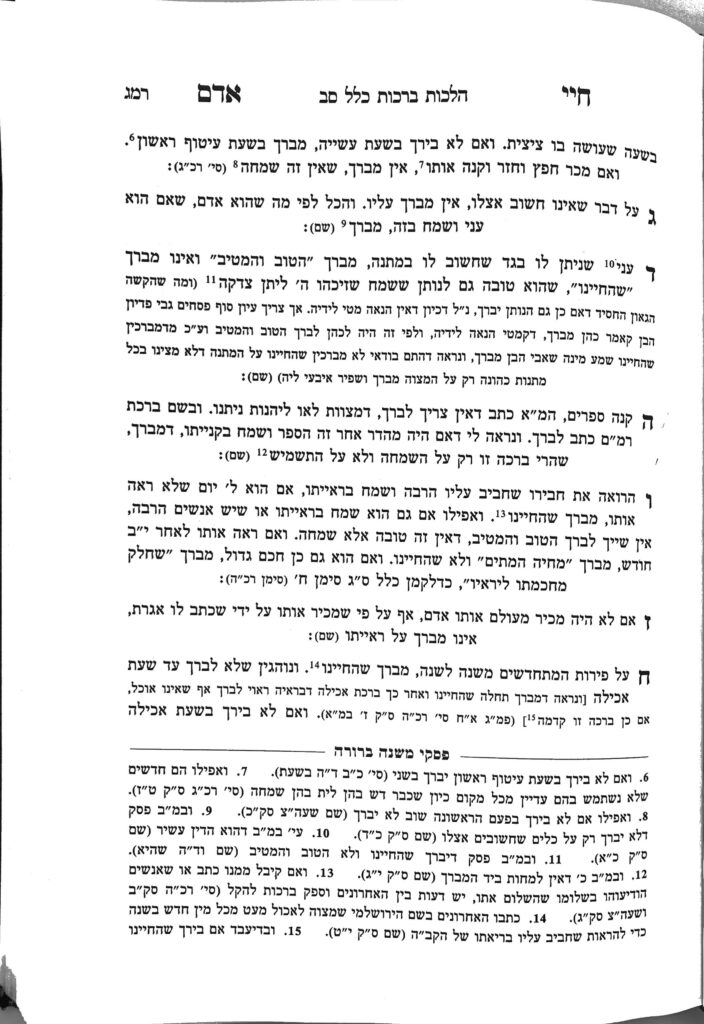We are continuing in siman 2. We learned that if one buys a new tallis, the proper time to make the shehecheyanu is when they string the tzitzis. If one buys the tallis with the tzitzis already strung, he should make the bracha when he first wears it.
We have learned that shehecheyanu should either be made when an item is first acquired, or, if the item is not yet usable, when the item is first worn. Since this tallis is not usable when it is first acquired (as it is missing tzitzis), the proper time to make the bracha should be when it is first worn. Why, then, does the Chayei Adam write to make the bracha when the tzitzis are strung?
The Mishnah Berurah, in siman 22 discusses this question. He explains that there is an opinion that one should make a shehecheyanu on the first time they do a mitzvah, such as the first time wearing tefillin or lighting shabbos candles. However, since it is a machlokes, we do not make the bracha out of safeik. However, since there is such an opinion, it is proper to try to make a shehecheyanu on a new fruit or the like concurrent with the new mitzvah, and to have the new mitzvah in mind when reciting the shehecheyanu.
Over here, since the tallis is a new article of clothing, it receives a shehecheyanu regardless of the mitzvah, but due to being a new garment. In addition, the mitzvah itself obligates a shehecheyanu, except that we do not make it out of safeik. The mitzvah of tzitzis begins already with stringing the tzitzis, as we learn from the pasuk (Bamidbar 15:38). Therefore, over here, where we already have a definite chiyuv to recite shehecheyanu due to the tallis being a garment, we make the bracha at the time of the fulfillment of the mitzvah in order to demonstrate that this item is not just for the purpose of clothing, but for a mitzvah as well.
If one does not make the bracha at the time of stringing the tzitzis, they make the bracha when they first wear it. The bracha of le’hisateif is made first, followed by shehecheyanu, because it is more tadir (occurring more frequently). Rav Chaim Kanievsky, shlita, holds that one should make the bracha le’hisateif, don the tallis fully, and only afterwards make the shehecheyanu, in order to minimize the hefsek between the first bracha and the donning of the tallis.
In regards to new tefillin, we learned that no shehecheyanu is made on fulfilling the mitzvah for the first time, due to the safeik mentioned above. Rav Shlomo Zalman Auerbach ztl gives a suggestion which allows bar mitzvah boys to make a shehecheyanu. If the father keeps ownership of the tefillin until the day of the bar mitzvah, and then gifts them to the bar mitzvah boy, in addition to doing the mitzvah for the first time as an adult, the bar mitzvah boy has just received a gift. In such a case, the bar mitzvah boy can make a shehecheyanu due to receiving a gift (as we will learn about further in this Klal). If the bar mitzvah boy purchased the tefillin with his own money, this suggestion would not apply.
Summary
- The correct time to recite the bracha depends on the usability of the item. If the item is usable at the time of acquisition, one recites the bracha immediately.
If the item is not usable at the time of acquisition, one should wait until the first time they use the item to make the bracha.
- Although it is a safeik whether one makes a shehecheyanu on a mitzvah item, one recites shehecheyanu on a tallis because it is also a garment.
- The optimal time to recite the bracha is when stringing the tzitzis. If one buys a tallis with the tzitzis already strung, they should recite the bracha when first wearing it.
- One should recite le’hisateif first, followed by shehecheyanu.
- One does not recite shehecheyanu on new tefillin.
- A bar mitzvah boy may recite shehecheyanu on his tefillin if the father gifts them to him on the day of his bar mitzvah. Thus, he can recite shehecheyanu due to the gift he received.



